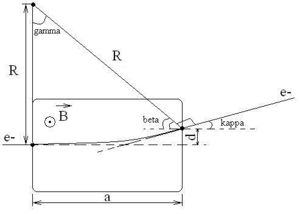Difference between revisions of "Kicker Magnets"
Jump to navigation
Jump to search
| Line 96: | Line 96: | ||
| − | |||
[http://wiki.iac.isu.edu/index.php/PhotoFission_with_Polarized_Photons_from_HRRL Go Back] | [http://wiki.iac.isu.edu/index.php/PhotoFission_with_Polarized_Photons_from_HRRL Go Back] | ||
Revision as of 16:32, 10 June 2010
Kicker Magnet Calculations
Field needed to bend 44 MeV electrons 0.47 degrees
, ,
- general expression for B-field.
If then and our B-field becomes:
for the coils under consideration. Hence, the B-field needed is:
Magnetic Field Produced by Coils
Assuming the coils we are using are in a solenoidal shape, we see that:
which gives us
These coils consist of 11 turns of which each turn is two deep. Furthermore, we have an inner and an outer radius . The above magnetic field can be found for both the inner and the outer layer of the coil for each turn of the coil. The maximum current these coils can handle (according to IAC personnel) is 100 Amps. Listed below is the data calculated for 100 Amps.
| Coil Number | Distance from Beam Pipe | Distance from Center of Beam Pipe | B-Field (inner) | B-Field (outer) |
| 1 | 0 cm | 2.5 cm | 0.00094392 T | 0.00097 T |
| 2 | 0 cm | 2.5 cm | 0.00094392 T | 0.00097 T |
| 3 | 0 cm | 2.5 cm | 0.00094392 T | 0.00097 T |
| 4 | 0 cm | 2.5 cm | 0.00094392 T | 0.00097 T |
| 5 | 0 cm | 2.5 cm | 0.00094392 T | 0.00097 T |
| 6 | 0 cm | 2.5 cm | 0.00094392 T | 0.00097 T |
| 7 | 0 cm | 2.5 cm | 0.00094392 T | 0.00097 T |
| 8 | 0 cm | 2.5 cm | 0.00094392 T | 0.00097 T |
| 9 | 0 cm | 2.5 cm | 0.00094392 T | 0.00097 T |
| 10 | 0 cm | 2.5 cm | 0.00094392 T | 0.00097 T |
| 11 | 0 cm | 2.5 cm | 0.00094392 T | 0.00097 T |
